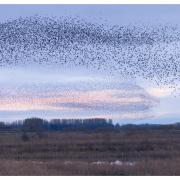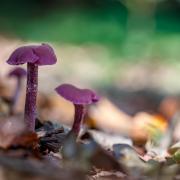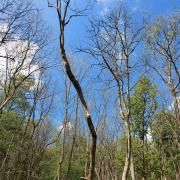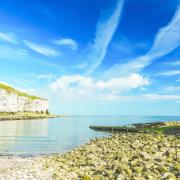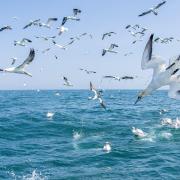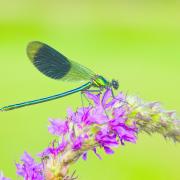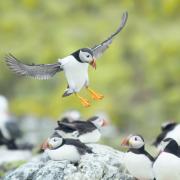Yorkshire Wildlife Trust’s Tom Marshall discovers that family and friends are not the only visitors we play host to at Christmas time

We are a nation of animal lovers in Britain, so it’s perhaps no surprise that wildlife is often at the heart of many important celebrations in our calendar.
Ask anyone to name a bird that symbolises Christmas then it must surely be the robin, the red-breasted, cheerful looking garden visitor who has adorned a million Christmas cards and fluffy tree decorations. Although we often think of robins as a quintessentially British feature of Christmas, the robin you see hopping across the lawn on December 25 in the snow (or perhaps more likely, drizzle) may, like the Three Kings, in fact be a visitor from afar.
Thousands of robins from Europe make their way to the UK every winter to escape harsher weather elsewhere. Although never a sure-fire clue, there’s some suggestion that robins with a more orange feathered winter jumper are those most likely to have made the trip from the continent. Yorkshire’s position on the east coast often finds it in the thick of the action during wintry north easterly winds, and robins can drop in to spots like Flamborough and Spurn Point in huge numbers in Autumn, before heading inland to bird tables across the county.
First appearing on Christmas cards over 150 years ago, robins seem keen to cement their place in our hearts every winter by providing a welcome song on a frosty morning – one of the few birds to do so throughout the dark days of winter.

These days you’re unlikely to find frankincense and myrrh among your presents, but there’s a real golden treat to look out for in the garden when the days get shorter. Weighing little more than some of the chocolate coins in your stocking, the goldcrest is arguably our smallest bird, but no less dazzling. A festive green jacket is complimented by a stunning flash of fiery golden yellow across its head, and when busily feeding they can often come remarkably close, despite being constantly moving balls of feathery energy. Your best chance is to look closely among larger flocks of tits and finches, as goldcrests are savvy enough to realise there’s always safety in numbers.
When it comes to the famed ‘seven swans-a-swimming’ from the popular carol, these may well have been mute swans – the most common visitor to our lakes, rivers and ponds. For a real slice of the frozen north at Christmas though, look no further than their arctic cousins Whooper swans. These high-flying travellers are told apart by their yellow and black beaks (unlike the orange of the mute swan); with each sporting its own unique pattern, along with an evocative hooting call that gives them their name. Breeding from Scandinavia to the Arctic Circle, Whoopers have even been spotted by airline pilots at more than 30,000ft while on migration. Once firmly on the ground, the Lower Derwent Valley and Wheldrake Ings near York are a favourite winter haunts, with more than 100 often seen on the flooded wetlands.
Twelve drummers drumming might be a bit much for most people, but the single stylish solo of a great spotted woodpecker could be an unexpected holiday treat. More likely to start their quintessential tapping during January and February in readiness for the spring ahead, a crisp and sunny December day might just tempt them into a short burst, still easily heard hundreds of metres away in woodlands, parks or large gardens.
As comforting as the rows of robins on cards along the mantelpiece, no Christmas table is complete without the ubiquitous bowl of nuts on the coffee table. But as the Queen’s speech plays and we take on the annual wrestling match with the nutcracker after a few sherries, the aptly-named nuthatch will be making short work of those same nuts on the feeder just outside the window.

Beautifully dressed in sky-blue and orange and like a small woodpecker that may have had a little too much Christmas dinner, the nuthatch is in fact incredibly agile – and the only British bird able to walk head-first both up and down trees (woodpeckers and treecreepers have to go backwards). This flexibility allows the nuthatch to not only collect nuts and seeds easily, but also allows it to locate the perfect cracks to place those same nuts, and apply the maximum force of its strong beak.
The turbulent tale of the turtle dove
According to the famed Christmas song, there were just two turtle doves, which is something of a reflection of the current state of this delightful but increasingly rare summer visitor to our shores. Unlikely to pop up in a festive tree in any form other than a bauble, ‘British’ turtle doves in fact spend the winter in sunnier climes of Africa, before making an ever more perilous migration across the Mediterranean every spring. Sadly, recent years have found the turtle dove becoming a tragic figurehead for the Maltese and Cypriot bird hunting seasons, which it’s thought in combination with gradual habitat loss in the UK has led to the sharp declines in this beautiful and culturally iconic bird. Although a recent bid to change the hunting rules lost out in a final vote, campaigners like Chris Packham continue to provide a voice for the turtle dove and others, while here in Yorkshire, the Wildlife Trust has been working with some of the region’s farmers to help develop the right habitats for those turtle doves who do make it to our shores every year.












